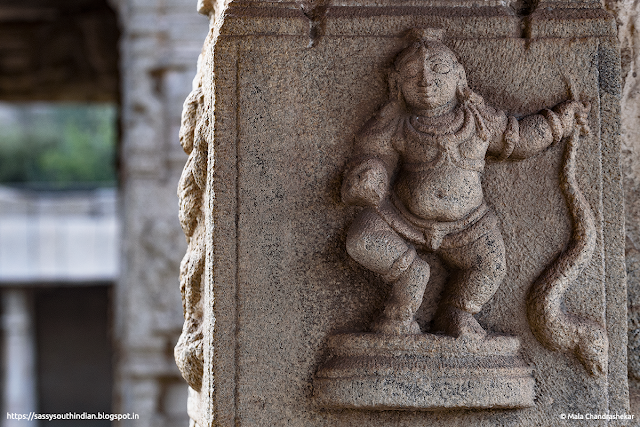King Achyuta Deva Raya, younger brother and
the last of the rulers before the near end of the glorious rule of the
Vijayanagara Kingdom – was handpicked by Krishna Deva Raya himself as an able
successor.
King Achyutaraya took to throne when the
empire was just beginning to face it’s unfavorable times. The opulence and
prosperity under Krishnadevaraya were at risk due to internal disagreements and
fights for the throne from contenders like Aliya Rama Raya and also the
constant infiltration efforts and feudatories who were waiting for an
opportunity to bring down the empire.
However, after the succession to the
throne in 1529, he built this stellar creation between the Gandhamadana and
Matanga hills dedicated to Lord Tiruvengalanatha,
a temple which became popularly known by his name as Achyutaraya Temple.
Reaching the temple structure
Although the structure is a prominent
part of the Hampi temple complex – the temple seems to be ‘off-track’ or
‘hidden’ and serves as a quiet abode for those who wish to spend some peace
time beyond the touristy areas.
This intricate and alluring temple
complex can be reached in two ways - You could take a side trip from the
Kodanda Rama Temple (Riverside Ruins path) that takes you to the main temple
entrance.
Or,
If you prefer to walk towards the Nandi – an alternate ascend through the steps
after the Bazaar street – that treats you with a magnanimous aerial view of the
temple from the hilltop.
The Temple Complex
Dwaram
A 'Dwara' or entrance in Hindu culture, represents a
progressive succession through spaces. The concept of decorative art or
intricate designs on the dwara represents an auspicious welcome and removal of
negative barriers through the designs.
The intricate design on the entrance are a representation
of the grandeur and the prosperity and the main sanctum is at the centre of two rectangular
courtyards.
The main shrine is
adorned by Yali’s Also known as the - Indian dragon form.These
dramatic and beautiful giant lion like forms are seen in a fighting posture. I
found these sculptures awe-inspiring- Here's what I found out about them during
my travel.
Yali / Vyala or Vidala ( in Sanskrit) is a mythical creature most often
sculpted onto the pillars of Hindu temples. It may be portrayed as part lion,
part elephant and part horse, and in similar forms and shapes .The reasoning
behind these sculptures on the pillars are a representation of life itself.
Life is far from being perfect - there are demonic, negative forces always at
play in this universe and true art, especially religious Hindu temple art was a
true representation of fighting imperfections.
As one enters the
inner sanctum, where the deity was supposedly placed - we come across the
‘Dwarapalakas’ or ‘deity guards’. There are multiple theories on Jaya-Vijaya the two sentinels whose job are to stand at
the entrance and keep watch while the Lord rests inside – And as per mythology
– I learnt that, one gets the permission mentally from Dwarapalakas, before
entering the temple with only to fulfill wishes if they have complete faith in
the Lord.
On the main shrine,on
closer look – one gets to see the references of Ramayana and Mahabharata
episodes portrayal etched beautifully on the rock pillars of the temple.
The above image is
a representation of the Ramayana episode : The top part of the pillar has
carvings where, Lord Hanuman (never ending tail) is sent to make peace with
Ravana and the duo are in conversation.
There is also a
carving which shows Sitadevi and Hanuman who gives her the precious jewel of
‘chintamani’ as a representation of Rama’s messenger and a vow to release her
from the captivity of Ravana.
Apart from these
scenes – there are some alluring depictions of ‘Muddu Krishna’ (Krishna as a
baby) playfully handling a snake.
And also another
image showcasing Krishna in a ‘tribhangi’ posture – I have personally seen some
well-known dancers potray this movement in the most delightful sensuous way.
The tribhangi is essentially a three
bends in the body - the neck, waist and knee, making one seem to form a gentle "S" shape
making it one of most alluring and graceful positions in dance forms potrayed
in representation of Krishna.
There are more
stupendous sculptures like the court dancer and a Jester showing off some of
his antics.
I could fill up
more web screens with the fluidity and wonderous sculptures the Achyutara
temple complex has -The grandeur and the intricate art of this temple structure
gives you a sense of reminiscing the glorious
times before the fall of the Vijayanagara empire and affluence of the kings who
were mighty interested in giving art and culture its due even at the very
impending end of prosperity.
Let’s set out on a
new photographic exploratory temple in my next blog.. More to come!
Have
you visited this place? Do
share your thoughts!
P.S.
Please note that all information are a part of history behind the temple
mythology (not mine) and the information may differ based on different
perspectives and narratives as the information is a reference from various
sources online. I am presenting here my understanding and perspective of the
same in a condensed format to keep the blog short and interesting.
You could comment
below if you wish to know more in detail about any specific details/
photographs mentioned.
















